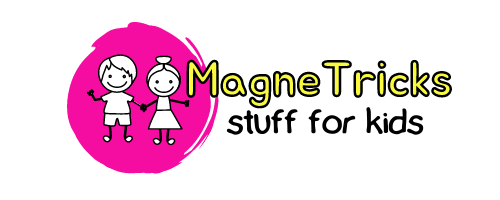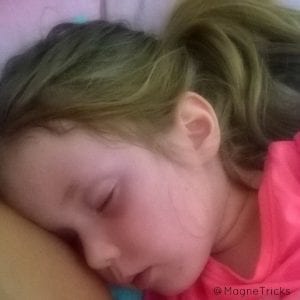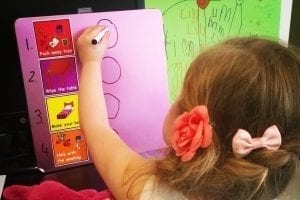Reward charts can work
Reward charts can be hit and miss, with all children. There are very subtle changes to how you use them that can determine whether they hit or miss.
Rewarding children when they behave as you would like is such an important part of parenting, and teaching.
All children respond differently to praise, reward and encouragement. Some children get shy or embarrassed with praise, others thrive on it. Then there are children who are indifferent and it seems to make very little impact. Regardless of how your child responds, a reward chart can always be utilised to maintain a positive focus.
MagneTricks reward charts are made to suit a range of families for a variety of purposes. All children learn differently and every family has a unique set of needs. I tried to make these reward charts as simple as possible so they can be applied in a range of situations.
Many mums and dads do however like some guidance with how to use these. So here I will give some tips on my idea of ‘best practice’ when it comes to rewarding your child/ren.
Goals are positive
Where possible, the goals for your child should always be positive. Instead of ‘Don’t shout’ you should refer to the behaviour you want to encourage – e.g. ‘Quiet voices’. The focus sets that come with our reward charts keep this in mind.
It's not about bribery or punishment
Reward charts are not designed as a tool to bribe your child/ren to do the right thing. They also shouldn’t be used as a punishment or consequence if your children fail. You need to have other strategies for consequence when dealing with undesirable behaviour. Leaving the reward chart to support positive behaviour and interaction. As parents, we often feel a need to ‘remind’ our children of systems to help them behave as they should. I’ve learned myself recently that letting this go is very very hard to do, but if you remind them you’re teaching them they don’t need to listen to you the first time.
Once you let this go, you start to learn they do actually hear you the first time and know how it works. They may forget from time to time that the tool is there but if you use the reward chart as I suggest, their reminder will be the reward chart itself. It is ok to say every now and again ‘remember that if you do __ you get a token on your chart’ but you must be aware of how often you do it and why you’re doing it. Bribing them away from doing the wrong thing takes away your power and the power of the chart – you want to use it to your advantage!
Talk about how it works with your child/ren
Before you use the reward chart it’s really important to explain how it will work. Talk about what they will get tokens for and explain that you will decide when they get a token for reaching a goal (they won’t always be able to get one). You also need to decide what will happen once they fill their reward chart with tokens. Sometimes this could be a snack or a special activity. You could also have a ‘family marble jar’ where marbles are added each time a member of the family completes their chart. Have a family reward for when the jar is filled. If your child/ren know about the final reward, it gives them an incentive to persist.
Focus on one thing at a time
I know it’s tempting to want to ‘fix’ every one of your child’s problem behaviours at once. It’s overwhelming, particularly for young children, to have many rules and goals and it becomes very difficult for them to focus and achieve what you want them to achieve. Focusing on one (or two) behaviours at any one time will make it much easier for them to succeed.
New behaviour or corrected behaviour
There is an important difference between these two types of focus and children will respond to these differently. Correcting a behaviour is typically harder for children (or anyone for that matter) to achieve. A goal where you’re trying to correct a behaviour should be very specific at first and can then become more generic.
My advice is that when using the focus ‘listening’ and your child is notorious for not listening, you start with one very simple aspect. Something like ‘Saying ‘yes mummy’ when I call your name’ – this is actually a new behaviour you’re trying to teach them, to correct a bad behaviour, and it’s a small step toward a bigger goal. A corrective focus you could use is ‘stop what you’re doing the first time mum and dad ask you to’. You know your child/ren better than anyone. Think about what the problems are and come up with small encouraging goals to assist with a bigger problem.
Set no time limit
Children become discouraged if they’re trying to achieve something within a given timeframe. Especially if the goal isn’t attainable within a timeframe. They often become stressed and desperate to reach their goal and it’s no longer a positive strategy. You should have a plan in your mind for how long you would like it to take for them to fill their reward chart – you are the best judge of your child/ren and how best to motivate them, but they must know that they’ll reach it and it’s ok if it takes a while.
Use a 'gradual release' approach for each focus behaviour
this will help you and your child get the most out of the reward chart without it causing problems. Your gradual release approach should resemble something like the following:
Here's the process
1
First use of the chart with a new focus
Speak to your child/ren about the focus and explain that they will receive a number of tokens each time they meet the goal behaviour. Maximising reward and praise initially will help the behaviour change quicker. You should aim for your child to fill the chart within the first day (depending on the focus you choose – sleeping and eating goals will obviously take a number of days) but do not express to your child that this is your goal or expectation. You give them the number of tokens required for them to complete the reward chart quickly and praise them for trying so hard. Once they fill it the first time, give them the first major reward and clear the chart to try again.
2
This time, you will lessen the number of tokens they get each time they display the behaviour
but it is very important you explain this to them first. “We’re going to use the reward chart again every time you do good listening, but this time we’ll see if you can do even better and fill up the chart one token at a time.” This time I would use one token each time they exhibit the desired behaviour (sometimes two, up to you). Keep in mind you want the reward chart to keep encouraging them so make sure they can achieve tokens frequently. You may need to repeat this step until the behaviour is more consistent – always be sure to explain how they will obtain tokens when you start again.
3
Finally we have 'rewarding consistency'
This is the final stage that will help your child apply the behaviour without the reward chart. Explain to your children exactly what they need to do to get a token. Here’s an example: “You’re so good at using the toilet now so it’s time to try something a bit trickier. You won’t get a token every time you go to the toilet now, you’ll get a token when you go by yourself every time and have no accidents. I’ll tell you to put a token or two on the chart when you have a really good day. After we finish the chart this time we need to do something really really special for being so amazing. I’m very proud of you.”
You then need to decide how often you will reward them for the consistency of the behaviour. If their behaviour is not yet consistent enough and you don’t feel like you can reward them for it, you need to go back to step 2. You may decide that each morning and evening, each day, each couple of days, you will give them a token for showing you they can do it. You can make it known to them that the goal is to do it consistently for that period of time in order to get a token, but just be careful not to make the goal so great that they feel it’s too hard and discourages them.
Now you can move onto a new focus once they have mastered the last. I still reward my daughter for previous focus behaviours when I start a new one, just to make sure the behaviour continues and I only reward her for consistency of the behaviour. Always make sure your child is aware of what you want from them and always make sure you praise and compliment them on achieving what you set out.
Final Point
a reward chart should be a positive experience for you and the kiddies! If either of you are finding that it’s not positive, you need to re-evaluate your approach and either pick a new and more specific focus, or modify how often they get a token and how many tokens they get. Enjoy sharing in and celebrating the achievements of your offspring.




